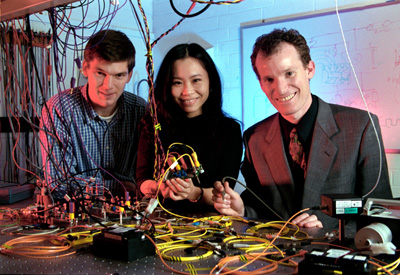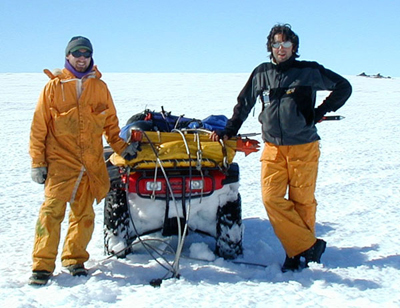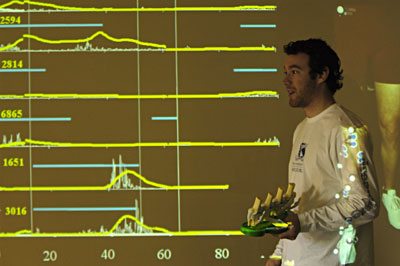By 2000, there were 4,000 undergraduate students enrolled in the Faculty, 25% of whom were full-fee international paying students who had come to Australia to study engineering. During the late 1990’s the School had developed its own international marketing arm that became the envy of the rest of the university. It was this group of people working with academics that helped the School attract so many excellent international students. The Faculty’s research reputation continued to grow and make a serious impact at the international level. The University began to rely significantly on full-fee paying income for its overheads, which accounted for over $10m per year.
Professor David Wood, Dean of the Faculty from 1997–2002, believed that the University needed to redesign its undergraduate programs to suit learning styles adopted by young children in their engagement with computer-driven activities. He believed that the Faculty was working with mid-late twentieth century techniques and its undergraduate programs were not tuned to the requirements of the 21st century. This laid the groundwork for the later changes to come in the undergraduate curriculum.
In 2003 Professor Jannie VanDeventer, a chemical engineering academic with expertise in minerals engineering was appointed Dean of the Faculty. The same year saw the opening of the four level extension to the Chemical Engineering Building. Named the Chemical and Biomolecular Engineering Building to reflect the Department’s new name the building incorporated a state-of-the-art 140-seat lecture theatre, with high quality chemical laboratories and offices. Later, the Electrical and Electronic Engineering Department would also be the recipient of a new extension to their building.
By 2004, the Faculty was receiving 45% of funding for teaching from government, 24% from fee income, 24% from other sources for Research and Training and 7% from other sources. Fees for international undergraduates were $24K p.a., and $26K p.a. for postgraduate places, with domestic fee-paying students paying $19K p.a. for undergraduate places and $21K p.a. for postgraduate places. HECS students paid $5367 p.a., and international and domestic fees were indexed at 3%. Professor Wood commented that the idea of Australia having a totally government-funded tertiary education was quite unrealistic if engineering faculties were to be progressive and offer teaching and research opportunities that were approaching world class. Although there was a fee increase in 2000, much of the increase had gone to provide equity scholarships.
By 2004, research centres in spatial information, advanced by-wire technologies, greenhouse gas technologies and perceptive and intelligent machines in complex environments were established, and the NITCA centre (National ICT Australia) opened. Supercomputers made mathematical calculations and analysis of huge volumes of data quicker, easier and more accurate. Most of the communication with students was done via email.
In 2004, led by the Times Higher Education World University Rankings, the new phenomenon of international rankings emerged and, over the decade, they were to grow into something of an obsession for both universities and students. For prospective students coming from overseas, faced with difficult choices between unfamiliar institutions, the easy comparisons that rankings provide were highly appealing. For Australian universities, it is gratifying to be ranked alongside well-regarded European and US schools and reap international enrolments that follow a good placement. In the Times Higher Education World University Rankings of 2004, Melbourne was ranked 22 in the world, with Engineering and IT also ranked 22. In following years our ranking was to bounce around in the world’s top forty institutions and many questions were asked about ranking methodology. However Engineering has performed consistently well across many of the different ranking systems and can be confident in its current number one ranking in Australia.
By the mid 2000s, the ratio of students to staff was 18:1; many classes were large with more than 400 students in compulsory core subjects and tutorials often greater than 60. Greater effort and resources were being put into the provision of services for students in areas such as transition both from school to university, and university to workforce, including mentoring and industry links and liaisons. The major changes from the mid 1990s to mid 2000s were geared towards running the University as a business, and inevitably, the decision-making at the university, faculty and departmental level moved in this direction. By 2005 the Faculty also offered a range of new courses including Biomedical Engineering, Engineering Management and Bimolecular Engineering.
Late in 2005, after a period of internal consultation, the University released the Growing Esteem document. This flagged major developments in the University’s strategic intentions for research, teaching and “knowledge transfer”, the three core activities known as the “triple helix”. The document announced that professional degrees such as engineering, law and medicine would move to graduate level, in line with the Bologna Accords, which had attempted to standardize Europe’s degrees to a 3+2+3 year cycle of bachelor, masters and doctoral qualifications.
Over the next two years, through rounds of planning and curriculum design, it was decided to reduce the number of undergraduate degrees offered by the University, from over 300 to less than 30. The Bachelor of Engineering was one of the degrees slated to go. Six “new generation bachelors degrees” — Arts, Biomedicine, Commerce, Environments, Music and Science — were to capture the majority of the University’s undergraduate enrolment. These six courses became the flagships for what was now known as “the Melbourne Model”. These degrees retained traditional majors, and would include majors leading to graduate study in fields such as engineering, medicine or architecture. “Breadth studies” were to be mandatory, with 25% of a student’s subjects to be taken outside of the home faculty and discipline. Breadth study and strong promotion of exchange opportunities or other international experiences would develop the range of perspectives and awareness to help graduates become active citizens in a complex world. It would develop skills required for international careers such as effective communication across cultures and disciplines. The deferral of professional training to graduate level would allow many students extra time to make their career decision during their university studies, rather than at high school.
After initial resistance, Engineering accepted the inevitability of the move to this graduate school model and a major curriculum overhaul commenced in late 2006. Throughout the first months of 2007 the Faculty’s Education Committee met regularly to develop the new curriculum ready for implementation in 2007. Undergraduate “Engineering Systems” majors were to be developed for three of these degrees (Science, Environments and Biomedicine, with a breadth sequence offered to Commerce students), which would then lead to a two year Master of Engineering, qualifying graduates for the profession. The Master of Engineering was to offer 11, individually accredited, streams:
- Biomedical
- Biomolecular
- Chemical
- Civil
- Electrical
- Environmental
- Geomatic
- Mechanical
- Mechatronic
- Software
- Structural
University of Melbourne students would enter these streams of the ME via eight undergraduate majors: biomedical systems, chemical systems, civil systems, electrical systems, geomatics, mechanical systems, physical systems and software systems. Students from outside the University, or without a specified major could take the ME as a three-year course if they met prerequisites in maths and science.
As the changes required a new round of accreditation from Engineers Australia, this curriculum overhaul allowed the School to better align its courses to the ideals of the “Washington Accords”, an international engineering education treaty to which Engineers Australia was a signatory. The Washington Accords looked to standardise recognition of professional engineering programs, worldwide, encouraging a breadth of content to facilitate the development of professional skills, ethics and environmental awareness on top of technical capability. The thirteen signatory countries included the US, UK, Japan, Hong Kong, Taiwan, South Korea, Canada and six other major industrial nations.
By 2008 Engineering was available as a five-year program, provisionally accredited by Engineers Australia, the Australian Computer Society, the Institution of Chemical Engineers, and the Royal Institution of Chartered Surveyors. The final intake for the Bachelor of Engineering was set for 2010, which would also see the launch of the Master of Engineering (in its three year guise). With the die cast on this radical change, the next couple of years saw much modelling of the likely flow through from the undergraduate degrees into the Master of Engineering, to see if the projected numbers really would add up. The School was proud of the quality of the new curriculum, which had led to the adoption of new teaching methods focused on problem-based learning. Students were to be guaranteed design, industry or research projects as well as industry involvement in at least 50 percent of ME subjects.
This new curriculum required a new type of classroom that was neither lecture theatre nor lab but a ‘collaborative learning space’, designed for group work. Building works commenced and, stylishly refitted, great swathes of the School started to look like candidates for an architecture magazine photoshoot.
Fears for the new program, however, were manifold. So-called ‘bright flight’ amongst local students was the first concern: would the Melbourne Model play into the hands of our competitor universities by driving away those top scoring students who wanted the quickest route into an engineering career? Would local students accept an extra year of study and HECS debt? Would international students (or their parents and sponsors) support an additional year of fees? Would students and parents understand the course structures and the reasons for this major change to the status quo? The University’s and the Schools communications went in to overdrive to overcome these doubts.
In 2011 we have the first real indications of the acceptance of the new Engineering program: a healthy body of University of Melbourne graduates have accepted places in the Master of Engineering, easily meeting the enrolment targets. The appeal of the course has registered strongly outside the university, with many students enrolling from other Victorian, Australian and international universities. Engineering appears to have passed its first test under the Melbourne Model and the five-year program can now build itself up to be the first choice of aspiring engineers everywhere.


